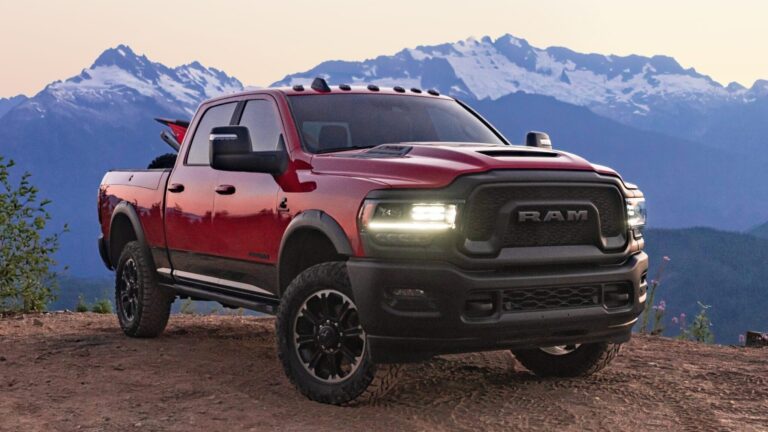Commercial Truck Value Report: Navigating the Complex World of Asset Valuation
Commercial Truck Value Report: Navigating the Complex World of Asset Valuation cars.truckstrend.com
In the high-stakes realm of commercial trucking, a single asset — the truck itself — represents a substantial investment, a critical tool, and a significant portion of a business’s capital. Understanding its true worth isn’t just a matter of curiosity; it’s a strategic imperative. This is where the Commercial Truck Value Report becomes an indispensable tool. Far more than a simple price tag, it’s a comprehensive, data-driven assessment that dissects every facet of a truck to determine its accurate market valuation. For fleet owners, owner-operators, lenders, insurers, and dealers alike, this report serves as the compass guiding critical decisions, from acquisition and financing to depreciation tracking and eventual resale.
The ability to accurately gauge a commercial truck’s value empowers stakeholders to make informed choices, mitigate risks, and optimize financial outcomes. It transforms guesswork into strategic planning, ensuring that every transaction, every insurance policy, and every asset management decision is anchored in objective reality.
Commercial Truck Value Report: Navigating the Complex World of Asset Valuation
Understanding the Commercial Truck Value Report: More Than Just a Number
A Commercial Truck Value Report is a detailed document that provides an expert assessment of a commercial truck’s current market value. It synthesizes a vast array of information, going far beyond basic make, model, and year. The report aims to establish a fair market value (FMV), wholesale value, or even liquidation value, depending on its intended use.
Key components typically found within such a report include:
- Vehicle Identification Number (VIN) and Detailed Specifications: The unique identifier, along with precise details on make, model, year, engine type (horsepower, torque), transmission type, axle configuration (e.g., 6×4, 4×2), Gross Vehicle Weight Rating (GVWR), and Gross Combination Weight Rating (GCWR).
- Mileage and Engine Hours: Crucial indicators of wear and tear, directly impacting a truck’s remaining useful life.
- Physical Condition Assessment: A thorough evaluation of the exterior (paint, body, frame integrity, rust), interior (seats, dashboard, sleeper area, amenities), and tire condition (tread depth, brand).
- Mechanical Condition Evaluation: An assessment of key components like the engine, transmission, differentials, brakes, suspension, HVAC system, and electrical components. This often relies on inspection reports or diagnostic scans.
- Maintenance and Service History: Documentation of past repairs, scheduled maintenance, and major component replacements. A comprehensive, well-documented history significantly boosts confidence and value.
- Accident and Damage History: Any reported incidents, their severity, and the quality of repairs.
- Aftermarket Modifications and Upgrades: Details on additions like Auxiliary Power Units (APUs), wet kits, custom interiors, or advanced safety systems, noting whether they add or detract value.
- Market Analysis and Trends: An overview of current supply and demand dynamics, economic indicators, fuel prices, and regional market specificities that influence valuation.


By meticulously compiling and analyzing these elements, the report provides a nuanced understanding of a truck’s standing in the current market, far surpassing a mere online listing price.
Why a Commercial Truck Value Report is Indispensable
The utility of a Commercial Truck Value Report extends across numerous scenarios, providing critical insights for various stakeholders:
- For Buyers (Owner-Operators & Fleet Owners): Before making a significant investment, a buyer can use the report to verify the seller’s asking price, negotiate effectively, and ensure they are not overpaying. It also helps in securing appropriate financing, as lenders rely on accurate valuations for collateral.
- For Sellers (Owner-Operators & Fleets Disposing of Assets): The report provides an objective basis for setting a realistic and competitive asking price, attracting serious buyers, and justifying the price during negotiations. It can significantly shorten the sales cycle and maximize returns.
- For Lenders and Financial Institutions: As collateral for loans, commercial trucks require precise valuation. The report helps lenders assess risk, determine loan-to-value ratios, and make sound lending decisions.
- For Insurance Companies: When underwriting policies or settling claims (e.g., total loss due to accident or theft), an accurate value report is essential to determine the correct payout, ensuring fairness for both the insurer and the policyholder.
- For Fleet Management and Accountants: Understanding the true value of assets is crucial for depreciation tracking, financial reporting, budgeting for replacements, and strategic asset disposal planning. It aids in optimizing the lifecycle management of a fleet.
- For Dealers and Auction Houses: These entities rely on accurate valuations for trade-ins, inventory pricing, and setting auction reserves, ensuring competitive positioning and profitable operations.

In essence, the report serves as a universal language for valuation, fostering transparency and confidence in transactions involving high-value commercial assets.
Key Factors Influencing Commercial Truck Value
While the report synthesizes many data points, some factors wield disproportionate influence over a commercial truck’s ultimate value:
- Core Specifications: The inherent quality and reputation of the make and model (e.g., Peterbilt, Kenworth, Freightliner, Volvo, Mack) play a significant role. Year of manufacture directly correlates with age and technological relevance. Engine specifications (horsepower, torque, fuel efficiency) and transmission type (manual vs. automatic) are critical, as they dictate performance and operational costs.
- Condition – Physical & Mechanical: This is paramount. A truck with a pristine exterior, well-maintained interior, and robust mechanical health (engine, transmission, differentials, brakes, suspension) will always command a premium. Conversely, signs of neglect, significant rust, frame damage, or major mechanical faults can drastically reduce value, often requiring costly repairs.
- Mileage and Engine Hours: While high mileage often implies more wear, the quality of those miles and the accompanying maintenance history are equally important. A well-maintained truck with higher mileage might be valued above a lower-mileage truck that has been neglected.
- Maintenance and Service History: Comprehensive, verifiable service records demonstrating regular preventative maintenance and timely repairs are invaluable. They provide tangible proof of a truck’s health and responsible ownership, significantly increasing buyer confidence and value. Lack of records or a history of skipped maintenance raises red flags.
- Accident History: Even minor accidents can raise concerns, but major collisions or those involving frame damage can severely devalue a truck, regardless of the quality of repair.
- Market Dynamics and Economic Conditions: The broader economic climate, freight rates, fuel prices, supply and demand for used trucks, and even regional demand can cause significant fluctuations in value. A strong economy with high freight demand typically drives up truck values.
- Aftermarket Modifications and Customizations: While some additions like APUs or wet kits can add value if they are in demand and professionally installed, highly specialized or poorly executed modifications can sometimes limit the buyer pool and even detract from value.
- Emissions Standards and Regulations: Increasingly, the compliance with current and upcoming emissions standards (e.g., EPA 2010, GHG 2021) impacts the desirability and resale value of older trucks, particularly in regions with strict regulations.
How to Obtain and Interpret a Commercial Truck Value Report
Obtaining a reliable Commercial Truck Value Report typically involves a few key avenues:
- Professional Appraisal Services: Independent, certified appraisers specialize in commercial vehicles. They conduct thorough physical inspections, review documentation, and analyze market data to provide a comprehensive report. This is often the most accurate and unbiased option.
- Specialized Valuation Platforms/Databases: Services like EquipmentWatch, Truck Paper, or Ritchie Bros. Auctioneers offer online valuation tools or historical sales data. While convenient, these may be less granular than a full appraisal and often rely on user-provided data for condition assessment.
- Dealership Trade-In Assessments: While useful for a quick estimate, these are often designed to favor the dealer’s buying position and may not reflect true market value.
To obtain a report, you will typically need to provide:
- The truck’s VIN.
- Detailed photos (interior, exterior, engine bay).
- Complete maintenance and service records.
- Any recent inspection reports or diagnostic readouts.
- Information on any modifications or unique features.
Interpreting the Report:
- Understand Value Types: Differentiate between Wholesale Value (what a dealer or auction house would pay), Retail Value (what a dealer would sell it for), and Fair Market Value (FMV), which is typically the price a willing buyer and seller would agree upon in an open market.
- Review All Sections: Don’t just look at the final number. Understand the rationale behind the valuation, especially the condition assessment and market analysis sections.
- Identify Red Flags: Note any discrepancies, missing information, or areas where the truck’s condition negatively impacts its value.
- Use it as a Tool: For buyers, it’s negotiation leverage. For sellers, it’s a justification for your asking price. For all, it’s a benchmark for future decisions.
Challenges and Considerations
While invaluable, commercial truck valuation is not without its complexities:
- Market Volatility: The commercial truck market can be highly susceptible to economic shifts, fuel prices, and freight demand, leading to rapid fluctuations in value. A report is a snapshot in time.
- Subjectivity in Assessment: While appraisers strive for objectivity, there can be slight variations in condition assessments or market interpretations between different valuation experts.
- Information Accuracy: The reliability of the report heavily depends on the accuracy and completeness of the information provided by the truck owner. Undisclosed issues can skew results.
- Specialized Equipment: Trucks with highly specialized bodies or custom configurations can be harder to value due to a smaller comparable market.
- Rapid Depreciation: Commercial trucks, especially new ones, experience significant initial depreciation. Understanding this curve is crucial for long-term asset management.
Maximizing Your Truck’s Value: Tips and Best Practices
Proactive management can significantly influence your truck’s value, regardless of market conditions:
- Regular, Documented Maintenance: This is the single most important factor. Stick to manufacturer-recommended service schedules and keep meticulous records.
- Timely Repairs: Address minor issues (e.g., dashboard warning lights, small fluid leaks) immediately before they escalate into costly major problems.
- Maintain Appearance: Regular cleaning, addressing cosmetic damage (dents, scratches, torn upholstery), and ensuring all lights and mirrors are intact contribute to a positive first impression.
- Tire Management: Good quality tires with ample tread depth add significant value.
- Professional Detailing: Before an appraisal or sale, a professional detail can make a considerable difference in perceived value.
- Understand Market Timing: If possible, try to sell when market demand is high and supply is lower. This may mean holding onto a truck a bit longer or accelerating a sale.
- Honesty and Transparency: Provide accurate information and disclose any known issues during the appraisal or sale process. This builds trust and avoids future disputes.
Table: Key Information & Impact in a Commercial Truck Value Report
| Category | Key Information/Metrics | Impact on Value | Typical Range/Examples (Illustrative) |
|---|---|---|---|
| Basic Specifications | Make, Model, Year, Engine (HP, Liters), Transmission Type, Axle Configuration (e.g., 6×4), Sleeper Size, GVWR/GCWR | Forms the base value; newer, more powerful, and versatile configurations command higher prices. | Example Models: 2020 Freightliner Cascadia, Volvo VNL 760, Peterbilt 579, Kenworth T680 |
| Mileage/Hours | Odometer Reading (miles), Engine Hours | Direct correlation; lower mileage/hours generally means higher value, assuming good maintenance. | Truck (Miles): <400,000 (Premium), 400,000-600,000 (Good), 600,000-800,000 (Average), >800,000 (Lower) |
| Physical Condition | Exterior (Paint, Body, Rust, Frame), Interior (Seats, Dash, Controls), Tires (Tread Depth), Lights | Significant impact; excellent condition commands premium (+5-15%), poor condition requires discounts for repairs (-10-25%). | Grade: A (Excellent), B (Good), C (Fair), D (Poor) |
| Mechanical Condition | Engine, Transmission, Differentials, Brakes, Suspension, HVAC, Electrical System, Exhaust System | Critical; major mechanical issues (e.g., needing engine overhaul) can drastically reduce value (20-50%+). | Status: Running Flawlessly, Needs Minor Repairs, Needs Major Repairs, Non-Running |
| Maintenance & History | Service Records (completeness, frequency), Accident History (minor vs. major), Ownership History | Boosts confidence and value; full records add 5-10%; major accidents can devalue by 15-30%+. | Records: Full/Verifiable, Partial/Limited, None. Accidents: Clean Title, Minor Collision, Major Collision |
| Market Factors | Current Supply/Demand, Economic Indicators, Fuel Prices, Freight Rates, Regional Demand, Emissions Standards | Can cause significant fluctuations (up to +/-20%); high demand/low supply pushes values up. | Market Trend: Rising, Stable, Declining. Regional Demand: High, Moderate, Low |
| Additional Features | APU, Wet Kit, Lift Axle, Custom Interior, Safety Systems (ADAS), Chrome Packages | Can add value if desirable and professionally installed (+ $2,000 – $15,000+). Some niche features may have limited appeal. | Condition of Add-on: Excellent, Good, Fair, Poor |
| Estimated Value Range | Wholesale Value, Retail Value, Fair Market Value, Liquidation Value | The final output of the report, providing a data-backed range for various transaction types. | Wholesale: $X – $Y; Retail: $A – $B (Ranges vary widely based on truck and market) |
Frequently Asked Questions (FAQ) About Commercial Truck Value Reports
Q1: What is the difference between wholesale and retail value?
A1: Wholesale value is the price a dealer or auction house would typically pay for a truck. Retail value is the price a dealer would then sell that truck for to an end-user, often including markups for reconditioning, overhead, and profit. A value report may provide both.
Q2: How often should I get a value report for my truck?
A2: For general fleet management, an annual or bi-annual report is usually sufficient. However, if you are planning to buy, sell, finance, or insure a truck, or if there are significant changes in market conditions, it’s advisable to get a recent report.
Q3: Can I get a report for a truck with very high mileage?
A3: Yes, absolutely. A value report can assess trucks of any mileage. While high mileage typically means lower value, the report will still provide an accurate valuation based on the truck’s condition, maintenance history, and the current market for similar high-mileage units.
Q4: Does a custom paint job or extensive chrome work increase my truck’s value?
A4: It depends. While personalized touches might appeal to some buyers, they can also limit the pool of potential buyers who prefer a standard look or want to customize themselves. If professionally done and well-maintained, it might add some value for the right buyer, but it’s rarely a dollar-for-dollar return on investment. Poorly executed customizations can even detract from value.
Q5: What role do emissions standards play in a truck’s value?
A5: A significant one. Trucks that meet newer, stricter emissions standards (e.g., EPA 2010, GHG 2021) are generally more desirable and command higher values, especially in regions with strict environmental regulations. Older, non-compliant trucks may face restrictions or higher operating costs, leading to lower demand and value.
Q6: Is an online valuation tool as accurate as a professional appraisal?
A6: Generally, no. Online tools rely on algorithms and broad market data, often without a detailed physical inspection or verification of maintenance records. A professional appraisal involves a hands-on inspection, detailed documentation review, and expert market analysis, leading to a much more precise and defensible valuation.
Q7: How long is a Commercial Truck Value Report valid?
A7: A value report is a snapshot in time. Given the dynamic nature of the commercial truck market, a report is typically considered valid for 30 to 90 days. Beyond that, significant market shifts or changes in the truck’s condition could render the valuation outdated.
Conclusion: Your Strategic Asset Management Partner
The Commercial Truck Value Report is more than a piece of paper; it’s a strategic asset management tool. In an industry where profitability often hinges on the efficient utilization and disposition of high-value assets, understanding the precise worth of your commercial truck is non-negotiable. Whether you’re an owner-operator planning your next upgrade, a fleet manager optimizing your balance sheet, a lender assessing risk, or an insurer settling a claim, this comprehensive report provides the clarity and confidence needed to make informed, financially sound decisions. By leveraging the insights from a Commercial Truck Value Report, you transform uncertainty into opportunity, ensuring that your valuable assets are managed with precision and foresight.






